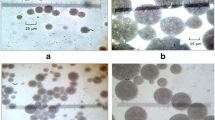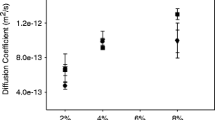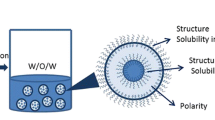Abstract
To obtain multiple emulsions containing Agnique™ AE 3-2H as oil phase and Atlas™ G-5000 as emulsifier, two formulation variables were studied: the effect of the Atlas™ G-5000 concentration in emulsions containing 15 wt% Agnique™ AE 3-2H and the study of the influence of the solvent concentration maintaining the Agnique™ AE 3-2H/Atlas™ G-5000 ratio equal to 10. To assess microstructure and physical stability of these emulsions different techniques were employed, namely laser diffraction, transmitted light optical microscopy, steady-state measurements, and multiple light scattering. An increase in copolymer concentration and solvent concentration provoked a decrease in Sauter diameter but an increase in volume mean diameter and polydispersion due to droplet coalescence. Regardless of polymer concentration, all emulsions showed Newtonian behavior which led to shear thinning with increasing oil concentration. The main destabilization processes are creaming, when the concentration of polymer or solvent is low, and coalescence, when both concentrations are high.







Similar content being viewed by others
References
Perrin P, Prigent F, Hébraud P (2008) Structure and rheology of stable multiple emulsions. In: Aserin A (ed) Multiple emulsions: technology and applications. John Wiley and Sons Inc, New Jersey, pp 29–43
ElShafei GMS, Elsaid MM, Attia HAE, Mohammed TGM (2010) Environmentally friendly pesticides: essential oil-based w/o/w multiple emulsions for antifungal formulations. Ind Crop Prod 31:99–106
McClements DJ (2012) Advances in fabrication of emulsions with enhanced functionality using structural design principles. Curr Opin Colloid Interface Sci 17:235–245
Aserin A (2008) Introduction to multiple emulsions technology and applications: an update. In: Aserin A (ed) Multiple emulsions: technology and applications. John Wiley and Sons, Inc, Hoboken, pp xix–xxi
Matsumoto S, Inoue T, Kohda M, Ohta T (1980) An attempt to estimate stability ofthe oil layer in W/O/W emulsions by means of viscosimetry. J Colloid Interface Sci 77:564–565
Ohwaki T, Machida R, Ozawa H, Kawashima Y, Hino T, Takeuchi H, Niwa T (1993) Improvement of the stability of water-in-oil-in-water multiple emulsions bythe addition of surfactants in the internal aqueous phase of the emulsions. Int J Pharm 93:61–74
Yan J, Pal R (2001) Osmotic swelling behavior of globules of W/O/W emulsion liquidmembranes. J Membrane Sci 190:79–91
Jager-Lezer N, Terrisse L, Bruneau F, Tokgoz S, Ferreira L, Clausse D, Seiller M, Grossiord JL (1997) Influence of lipophilic surfactant on the release kinetics ofwater- ofwater-soluble molecules entrapped in a W/O/W multiple emulsions. J Control Release 45:1–13
Zhao C-X (2013) Multiphase flow microfluidics for the production of single or multiple emulsions for drug delivery. Adv Drug Deliv Rev 65:1420–1446
Jiménez-Colmenero F (2013) Potential applications of multiple emulsions in thedevelopment of healthy and functional foods. Food Res Int 52:64–74
Bigorra J, Cognis Iberia-Castellbisba (2010) Innovative solvents based on renewableraw material. In: 40th Jornadas Anuales del CED, España, pp. 1–11
Hottois D, Bruneau A, Bogaert JC, Coszach P (2010) Manufacture of lactic acid esters, in: Belgium Patent BE1017951A320100112
Merlet S, Munzenberg C, Wiethoff H (2011) Biocide compositions comprising car-bamates, in: PCT Patent WO2011060890A120110526
Mertoglu M, Mayer W, Strobel D, Berghaus R, Strathmann S (2011) Anhydrous com-position comprising a dissolved and a suspended pesticide, alkyl lactate and alcohol. In: PCT Patent WO2011098419A220110818
Höfer R, Bigorra J (2007) Green chemistry—a sustainable solution for industrial spe-cialties applications. Green Chem 9:203–212
Merlet S, Bigorra J, Raya J, Valls R, Busch S (2012) Biocide compositions comprising amides based on 2-furoic acid and its derivatives, with high solubility and improved emulsification properties. In: PCT PatentWO2012038306A120120329
Michaut F, Hébraud J, Perrin P (2003) Amphiphilic polyelectrolyte for stabilization of multiple emulsions. Polym Int 52:594–601
Tadros TF (2009) Colloids and interface science series 5: colloids in agrochemicals. WILEY-VCH Verlag CmbH & Co. KGaA, Weinheim
Magdassi S, Garti N (1986) A kinetic model for release of electrolytes from w/o/w multiple emulsions. J Control Release 3(1–4):273–277. https://doi.org/10.1016/0168-3659(86)90098-2
Hong L, Sum G, Cai J, Ngai T (2012) One-step formation of w/o/w multiple emulsions stabilized by single amphiphilic block copolymers. Lagmuir 28:2332–2336. https://doi.org/10.1021/la205108w
Lutz R (2008) Aserin a (2008) multiple emulsions stabilized by biopolymers. In: Aserin A (ed) Multiple emulsions: technology and applications. John Wiley and Sons, Inc, Hoboken
García MC, Muñoz J, Alfaro MC, Franco JM (2014) Physical characterization of multiple emulsions formulated with a green solvent and different HLB block copolymers. Colloids Surf A Physicochem Eng Asp 458:40–47
García MC, Cox P, Trujillo-Cayado L, Muñoz J, Alfaro MC (2018) Rheology, microstructural characterization and physical stability of W/α-PINENE/W emulsions formulated with copolymers. Colloids Surf A Colloids Surf A 536:125–132. https://doi.org/10.1016/j.colsurfa.2017.07.029
García MC, Muñoz J, Alfaro MC, Franco JM (2013) Assessment of wall-depletion phenomena in dilute emulsions. In: Rubio-Hernández FJ, Gómez-Merino AI, Pino C, Parras L, Campo-Deaño L, Galindo-Rosales FJ, Velázquez-Naverro JF (eds) Perspectives in fundamental and applied rheology. Grupo Español de Reología, Málaga, pp 297–301
Pons R (2000) Polymeric surfactants as emulsions stabilizers. In: Paschalis A, Björn L (eds) Amphiphilic block copolymers: self-assembly and applications. Elsevier Science B. V, Amsterdam, pp 409–422
Schuch A, Leal LG, Schuchmann HP (2014) Production of W/O/W double emulsions. Part I: visual observation of deformation and breakup of double emulsion drops and coalescence of the inner droplets. Colloids Surf A Physicochem Eng Asp 462:336–343
Mengual O, Meunier G, Cayre I, Puech K, Snabre P (1999) Characterisation of instability of concentrated dispersions by a new optical analyser: the TURBISCAN MA 1000. Colloids Surf A Physicochem Eng Asp 152:111–123
Palazolo G, Sorgentini A, Wagner J (2005) Coalescence and flocculation in o/w emulsions of native and denatured whey soy proteins in comparison with soy protein isolates. Food Hydrocoll 19:595–604
García MC, Alfaro MC, Calero N, Muñoz J (2014) Influence of polysaccharides on the rheology and stabilization of α-pinene emulsions. Carbohydr Polym 105:177–183
Khopkar A r, Fradett L, Tanguy PA (2009) Emulsification capability of a dual shaft mixer. Chem Eng Res Des 87(12):1631–1639
Grossiord JL, Seiller M (1998) Applications. In: Grossiord JL, Seiller M (eds) Multiple emulsions: structure, properties and applications. Editions de Sante´, Paris, pp 279–437
Acknowledgments
The financial support received from the Spanish Ministerio de Economía y Competitividad (MINECO) and FEDER, UE is kindly acknowledged (project CTQ2015-70700-P).
Author information
Authors and Affiliations
Corresponding author
Ethics declarations
Conflict of interest
The authors declare that they have no conflicts of interest.
Additional information
Publisher’s note
Springer Nature remains neutral with regard to jurisdictional claims in published maps and institutional affiliations.
Rights and permissions
About this article
Cite this article
García, M.C., Muñoz, J., Alfaro-Rodriguez, MC. et al. Formulation variables influencing the properties and physical stability of green multiple emulsions stabilized with a copolymer. Colloid Polym Sci 297, 1095–1104 (2019). https://doi.org/10.1007/s00396-019-04529-y
Received:
Revised:
Accepted:
Published:
Issue Date:
DOI: https://doi.org/10.1007/s00396-019-04529-y




